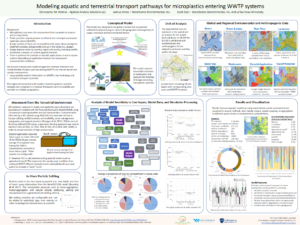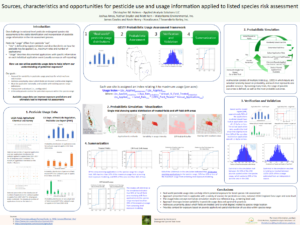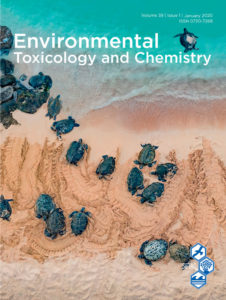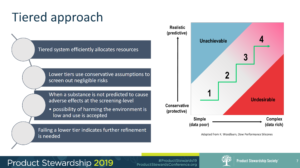2019
Holmes, C.M. (Applied Analysis Solutions, LLC); Maltby, L. (The University of Sheffield); Marshall, S. (Consultant, UK); Otte, J.C. (BASF); Sweeney, P. (Syngenta); Thorbek, P. (BASF)
Geospatial Approaches to Increasing the Ecological Relevance of Environmental Risk Assessment Conference
2019.
Abstract | Links | Tags: 2019, Poster, SETAC North America
@conference{2019NAGeo,
title = {Geospatial Approaches to Increasing the Ecological Relevance of Environmental Risk Assessment},
author = {Holmes, C.M. (Applied Analysis Solutions, LLC) and Maltby, L. (The University of Sheffield) and Marshall, S. (Consultant, UK) and Otte, J.C. (BASF) and Sweeney, P. (Syngenta) and Thorbek, P. (BASF)},
url = {https://appliedanalysis.solutions/wp-content/uploads/2020/01/SETAC-NA-ECETOC-TF-poster-01Nov2019.pdf, View poster},
year = {2019},
date = {2019-11-03},
urldate = {2019-11-03},
abstract = {For several decades, the prospective risk assessment of chemicals has followed a generic approach of comparing estimated exposures to toxic thresholds designed to be protective of all species (i.e., assessing exposure to the most sensitive species assumed to be located anywhere the chemical may occur in the environment). This approach does not recognize geographic patterns of species distributions or acknowledge that particularly sensitive species may not occupy potentially exposed habitats. Therefore, risk assessments could be overly conservative and restrictive for some uses of chemicals. Approaches for making spatially explicit assessments of chemical exposure are relatively advanced but this is not the case for mapping and assessing ecological data. However, geo-referenced ecological data appear to be increasingly available at spatial resolutions applicable to chemical risk assessment, potentially facilitating enhanced environmental relevance of such risk assessments. In 2017 a Task Force was initiated by European Centre for Ecotoxicology and Toxicology of Chemicals (ECETOC) to assess the capability of making chemical risk assessments using available geospatially referenced chemical exposure, ecological receptor and ecosystem services data. Two case studies were developed to illustrate the potential to assess geo-referenced risks to ecological receptors in fresh water and terrestrial environments exposed to i) a chemical used in consumer cleaning products discharged via municipal WWTPs across the EU and ii) a range of representative active ingredients used in plant protection products on selected crops in Germany. After initially compiling a catalogue of available geo-referenced ecological data for Europe, geo-referenced exposure concentrations were derived by combining accessible chemical use and fate data with conventional exposure models. However, use of many ecological data sets over a pan-European range proved problematic due to data access issues, limited geographic coverage and unreliable quality. Nevertheless, several suitable ecological data sets were accessed after making specific requests to various organizations within national authorities and these were integrated with the exposure maps. The results of these case studies give an indication of the potential value of making geo-referenced chemical risk assessments as well as the limitations to current capability.},
keywords = {2019, Poster, SETAC North America},
pubstate = {published},
tppubtype = {conference}
}
Holmes, C.M. (Applied Analysis Solutions, LLC); Amos, J. (Waterborne Environmental, Inc); Dyer, S. (Waterborne Environmental, Inc)
Modeling Aquatic and Terrestrial Transport Pathways for Microplastics Entering WWTP Systems Presentation
11.03.2019.
Abstract | Links | Tags: 2019, Poster, SETAC North America
@misc{2019NAWWTP,
title = {Modeling Aquatic and Terrestrial Transport Pathways for Microplastics Entering WWTP Systems},
author = {Holmes, C.M. (Applied Analysis Solutions, LLC) and Amos, J. (Waterborne Environmental, Inc) and Dyer, S. (Waterborne Environmental, Inc)},
url = {https://appliedanalysis.solutions/wp-content/uploads/2020/01/SETAC-NA-Particle-model-poster-01Nov2019.pdf, View poster},
year = {2019},
date = {2019-11-03},
urldate = {2019-11-03},
abstract = {Microplastics may enter the environment from a number of sources and in many forms. Plastic particles may be present as influent into municipal wastewater treatment plants (WWTPs). A large portion of these are removed from the water phase during the treatment process, and generally end up in the solids (i.e., sludge). Sludge disposal varies by country, region and locality, including landfill, incinerator, compost, or as land-applied biosolids. There is potential for particles in biosolid applications to reach aquatic systems depending on application location and subsequent environmental conditions. We present a broad-scale model designed to estimate emissions and model the fate of plastic particles exiting WWTPs into the terrestrial and aquatic environments, using spatially-explicit information on WWTPs, river hydrology and terrestrial transport potential. This regional/continental scale model is based on publicly available datasets and contained in a modular and transparent framework which is scalable and portable to multiple geographies. This presentation will demonstrate the utility of the model as applied to different regions, and how the resulting information about ultimate mass disposition within the environment (e.g., soil, freshwater, sediment, marine) and surface water concentrations can be examined to help inform the discussion about prospectively assessing the presence and concentration of microplastic particles in the environment as emitted by WWTPs.},
keywords = {2019, Poster, SETAC North America},
pubstate = {published},
tppubtype = {presentation}
}
Holmes, C.M. (Applied Analysis Solutions, LLC); Amos, J. (Waterborne Environmental, Inc); Snyder, N. (Waterborne Environmental, Inc); Kern, M. (Waterborne Environmental, Inc); Cowles, J. (Tessenderlo Kerley, Inc.); Henry, K. (Tessenderlo Kerley, Inc.)
11.03.2019.
Abstract | Links | Tags: 2019, Poster, SETAC North America
@misc{2019NAPest,
title = {Sources, Characteristics and Opportunities for Pesticide Use and Usage Information Applied to Listed Species Risk Assessment},
author = {Holmes, C.M. (Applied Analysis Solutions, LLC) and Amos, J. (Waterborne Environmental, Inc) and Snyder, N. (Waterborne Environmental, Inc) and Kern, M. (Waterborne Environmental, Inc) and Cowles, J. (Tessenderlo Kerley, Inc.) and Henry, K. (Tessenderlo Kerley, Inc.)},
url = {https://appliedanalysis.solutions/wp-content/uploads/2020/06/SETAC-NA-GESTF-Usage-poster-01Nov2019.pdf, View poster},
year = {2019},
date = {2019-11-03},
urldate = {2019-11-03},
abstract = {The challenges inherent in national-level pesticide endangered species risk assessments are many, varied and have been the topic of meetings, workshops, presentations and publications for many years. One challenge is the identification and incorporation of pesticide usage information in the risk assessment process. Pesticide “usage” differs from pesticide “use”, where “use” is defined by registered labels and describes limits on how the pesticide may be applied (i.e., maximum rates and number of applications), while “usage” describes documented applications with specific information on each individual event. Incorporating usage information into the risk characterization during the Biological Evaluation and Biological Opinion development process is an area of renewed interest. This poster will describe several sources of pesticide usage information (e.g., USDA Agricultural Chemical Use Program, CA DPR Pesticide Use Reporting), and how relevant field-level pesticide application information can be extracted. Examples will be given showing how these data can be utilized to refine our understanding of specific active ingredients and their associated spatial and temporal variation across use areas, and how this can inform the exposure analysis within each Step of the ESA consultation process.},
keywords = {2019, Poster, SETAC North America},
pubstate = {published},
tppubtype = {presentation}
}
Holmes, C.M. (Waterborne Environmental, Inc); Dyer, S. (Waterborne Environmental, Inc); Vamshi, R. (Waterborne Environmental, Inc); Maples-Reynolds, N. (Waterborne Environmental, Inc); Davies, I.A. (Personal Care Products Council)
In: Environmental Toxicology & Chemistry, vol. 39, no. 1, pp. 210-219, 2019.
Abstract | Links | Tags: 2019, Peer-Reviewed Publication
@article{ETC210,
title = {A National‐Scale Framework for Visualizing Riverine Concentrations of Microplastics Released from Municipal Wastewater Treatment Incorporating Generalized Instream Losses},
author = {Holmes, C.M. (Waterborne Environmental, Inc) and Dyer, S. (Waterborne Environmental, Inc) and Vamshi, R. (Waterborne Environmental, Inc) and Maples-Reynolds, N. (Waterborne Environmental, Inc) and Davies, I.A. (Personal Care Products Council)},
url = {https://setac.onlinelibrary.wiley.com/doi/abs/10.1002/etc.4610, View Online},
doi = {https://doi.org/10.1002/etc.4610},
year = {2019},
date = {2019-10-09},
urldate = {2019-10-09},
journal = {Environmental Toxicology & Chemistry},
volume = {39},
number = {1},
pages = {210-219},
abstract = {Down‐the‐drain exposure models provide a valuable tool for estimating environmental exposure to substances which are treated and discharged by municipal wastewater‐treatment plants (WWTPs). Microplastics may enter WWTPs from consumer activities and disposal. An exposure framework was developed using the iSTREEM® model, which estimates spatially explicit concentrations of substances in riverine systems across the United States and portions of Ontario, Canada. One hundred simulations covering a range of WWTP removal and instream loss rates (proxy for net sedimentation) were incorporated into a Web‐based visualization tool for user exploration of relative concentrations across simulations. Surface water concentrations specific to user‐supplied tonnage were examined via interactive heat maps and cumulative distributions. Exploring the spatial aspect of iSTREEM results showed that modeling 90% WWTP removal and no instream loss resulted in 8.5% of the mass entering WWTPs discharged to marine estuaries (7.4%) or Great Lakes (1.1%) environments, with the remainder of the mass discharged (1.5%) in inland sinks or exiting the United States via rivers. Modeling an example instream loss of k = 0.1 d–1 (i.e., half‐life = 7 d), terminal river segments contained 3.3% of influent mass (2.3% marine estuaries, 1.0% Great Lakes). Varying instream loss rates had substantial impacts on the total mass exported. The Web‐based tool provided a user‐based mechanism to visualize relative freshwater concentrations of microplastics across a large geographic area by varying simplified particle fate assumptions. Environ Toxicol Chem 2019;39:210–219. © 2019 SETAC},
keywords = {2019, Peer-Reviewed Publication},
pubstate = {published},
tppubtype = {article}
}
Holmes, C.M. (Applied Analysis Solutions, LLC); DeLeo, P. (Integral Consulting, Inc); Kransler, K. (SI Group); Carrar, A. (Kao Corporation)
Tiers for Fears: Applying Fit-for-Purpose Risk Assessment in Environmental Stewardship Presentation
09.10.2019.
Abstract | Links | Tags: 2019, Presentation
@misc{2019PSC,
title = { Tiers for Fears: Applying Fit-for-Purpose Risk Assessment in Environmental Stewardship},
author = {Holmes, C.M. (Applied Analysis Solutions, LLC) and DeLeo, P. (Integral Consulting, Inc) and Kransler, K. (SI Group) and Carrar, A. (Kao Corporation)},
url = {https://appliedanalysis.solutions/wp-content/uploads/2020/01/PS2019-Tiers-for-Fears_Session-2-Holmes.pdf, View Presentation},
year = {2019},
date = {2019-09-10},
urldate = {2019-09-10},
abstract = {Proper environmental stewardship of products necessitates an understanding of materials in use and potential impacts to humans and wildlife from environmental releases. However, there are limits to resources that may be devoted to such efforts. The trick is in knowing How much is enough? A tiered risk assessment methodology uses an iterative approach of increasingly sophisticated investigation for those instances where the substance assessment requires additional information. This session will discuss the tiered assessment paradigm as it applies to environmental hazards and exposures, and present methods and models used to refine our understanding of potential risk. For example, environmental releases can occur during various stages of a product's life-cycle such as manufacture, use and disposal. Screening and higher-tier exposure and fate models used to predict environmental concentrations will be discussed. Likewise, the spectrum of hazard data acquisition will be explored from use of existing data directly or through read-across, computational methods, laboratory investigations and field studies. Case studies will be presented illustrating real-world application of these methods across diverse chemistries and products.},
keywords = {2019, Presentation},
pubstate = {published},
tppubtype = {presentation}
}





